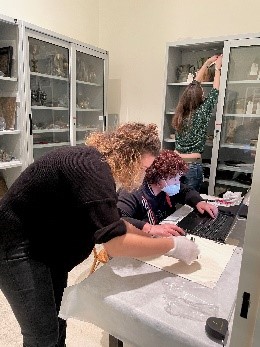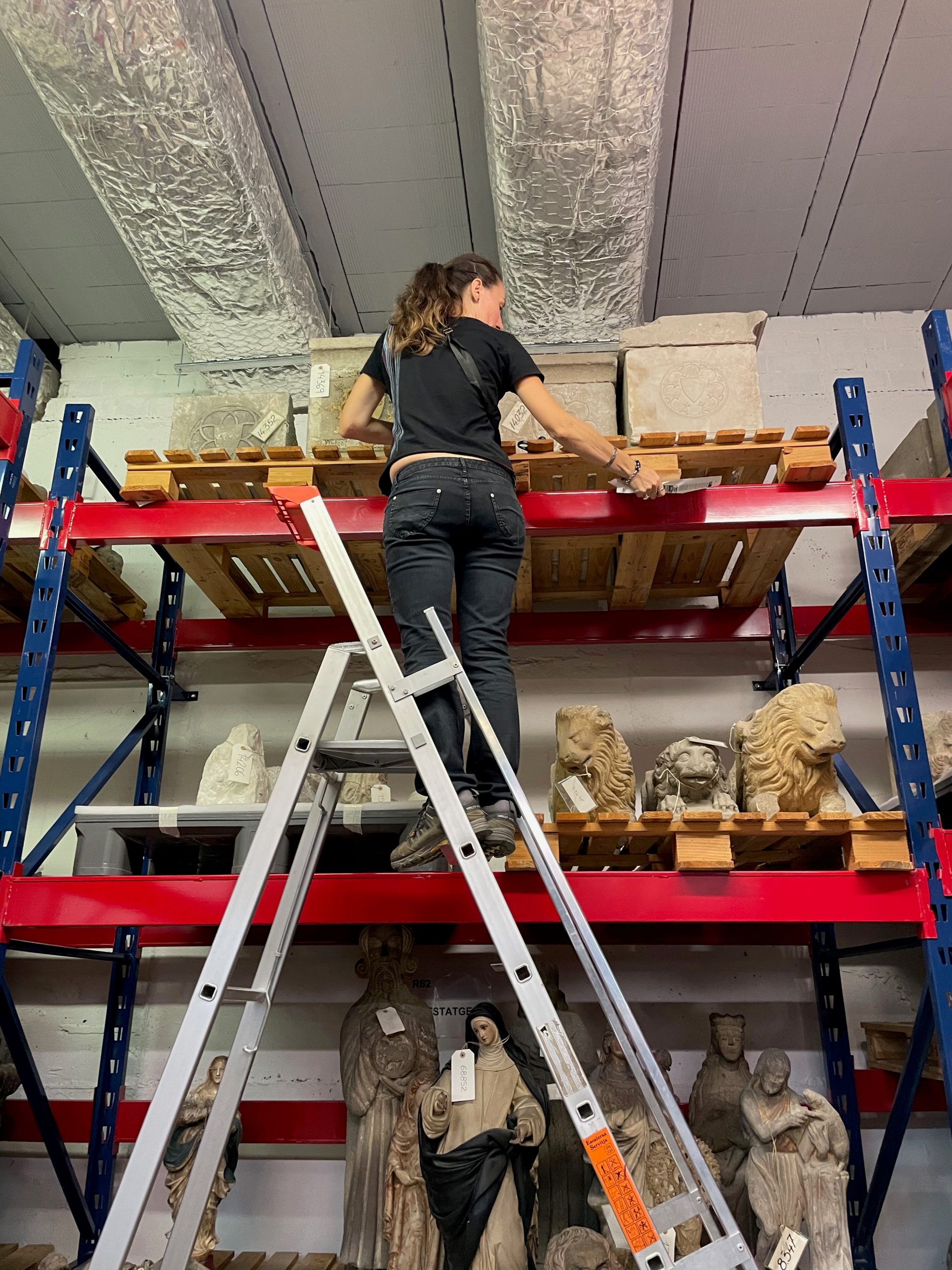Mónica Baró / Neus Conte / Marta Masafret
Mónica Baró has been working at the museum since 2004. She entered the Commercial Management department as an intern and later occupied a vacancy that had arisen in that department. Since 2011 she has been a member of the Registration and Exhibitions department’s team, where she has performed a variety of tasks. She is now a technician in the Registration department.
Neus Conte has been working at the museum since 1990, entering the collections of the former Museum of Modern Art into the database that was then being used (DATAPRO). She has always worked in collections document management. She is currently in charge of the MuseumPlus management system in the Registration and Exhibitions department.
Marta Masafret Seoane has been at the museum since 1997. She entered the Archive department as an intern and worked there until 2010. She is now a member of the Registration and Exhibitions department’s team, where she works as a technician in the Collections Documentation section that is responsible for the Collections Management System (MuseumPlus).
Very often, when we go to visit a museum, we are not aware that what is exhibited in the rooms is just a small part of its collections. Most museums, especially public museums and/or those the size of the Museu Nacional d’Art de Catalunya, keep most of their collections in what are known as storage rooms, where unexhibited works are kept.
In this post, with a few examples we wish to tell you about the fundamental work that the small Registration team is doing in these storage rooms. We can assure you that going through them thoroughly is becoming a motivation. We apply what we know from our experience in museums; in return the storage rooms, in their own way, show us the singular nature of each of the works contained in them.

Correct management of the storage rooms is vitally important, from both the documentary point of view (locating the works at all times), and from the logistical one (optimizing the space in them). This was the reason why the Registration department presented a general plan of action for the museum’s storage rooms, with the aim of optimizing the spaces and inspecting each of the storage rooms in detail in order to carry out an exhaustive study of the needs, the problems, and the improvements to be made in the short and medium term.
The museum currently has 19 storage spaces, in which the works are distributed according to their physical characteristics (stone, wood, paper, etc.), since each material has different conservation needs. In each space, the protocols for environmental control, cleaning and security are observed.
We began this project in March 2021, working in the storage rooms that had not been inspected for the longest period of time because they contain works that are not normally moved. For example, in storage rooms RS2 and RS3 we find large-size works in stone, marble, alabaster, bronze and terracotta, and in RS1, small works that must be kept under lock and key in cupboards and with a security camera to prevent them from being lost.
The inspection system was simple: it was necessary to go into each of the different storage rooms and check that all the objects in that particular place had the file corresponding to the Museum Document Management System (MuseumPlus), and that the information concerning their location was correct.

Storage room RS2.
There was no specific time limit for making the inspection, as we did not know exactly how long it would take to check, or the amount of time we would have to do it, since it had to be done along with all the department’s other activities/functions. Initially, we thought that it would be a relatively quick job, but virtually from day one we saw that it would not be, as we started to detect objects that had not been inventoried, that were not marked with an inventory number, that had duplicated inventory numbers, spaces that did not have proper signage, works we were unable to handle, etc.
Therefore, we realized that it was necessary to reconsider the way of making the inspection and to take the opportunity to:
- Renumber the storage rooms, making use of the recommendations of RE-ORG with the aid of our colleague Benoît de Tapol, a Restoration and Preventive Conservation technician.
- Photograph, take measurements and create a document with the uninventoried works that we were finding and where other kinds of incidents would also be noted down.
- Signposting the new locations with the new nomenclature.

Working in the storage room RS1.
Changing the nomenclature from the current location thesaurus to the type of numbering recommended by RE-ORG has led to a change in the location thesaurus descriptors, and to the old and new nomenclatures existing side by side, something that is gradually changing as the specific storage room is inspected.

Old storeroom nomenclature / New nomenclature
As the thesaurus is changed on MuseumPlus, the new nomenclature is incorporated in the storage rooms.


Old RS3 topographic / New RS3 topographic according to RE-ORG
It is important to mention that in some of the incidents found, like works marked with an old number, this number has enabled us to study their provenance. In some cases, we have found works that had a label with the catalogue number of the Provincial Museum, which helped us to learn about the way they entered (donation, purchase, etc.), and, often, where the work had come from. Having reached this point, it was necessary to review the old filing cabinets and the registration books in order to note the original number with which the work was inventoried.
We would like to illustrate a very exceptional example for you: a work that did not have a label with an inventory number, but which was marked. In our initial working list taken from the MuseumPlus programme, the work had a different registration number. With these data, we consulted the old files and the registration book, which confirmed for us that the correct number was the one from the initial list, in this case the one corresponding to 153314-000, and that the number marked, 69378, belonged to another work. For this reason, markings must be erased, and we will thus avoid possible further doubts in the future. This information (marked number) was entered in the MuseumPlus file as an old number. That inventory number might possibly have been duplicated and, when they realized, they changed the number of this work to a new one and did not erase the marking, something that has now caused us to doubt and check the old files again. It is now noted down in our record of incidents that the erroneous inventory number must be erased and the correct number must be marked.

During this time, our work has progressed. After inspecting four of the museum’s storage rooms (RS1, RS2, RS3, RS4), and bearing in mind the number of incidents detected and the few means at our disposal, we believe it is necessary to add the following parameters/elements to the project with the aim of maximizing the time and the resources invested in it:

- Creating a committee (with conservators, experts, restorers) to study the works that have not been entered in MuseumPlus for the purpose of deciding whether or not to inventory them. If not, then make a parallel study of where to put these works: one possibility would be to rent an external storage room in which to deposit them temporarily, for example. In this way we would make more room in the storage rooms.
- Setting up a marking work team (with Registration, Museography and Restoration technicians) which would allow all the works to be correctly inventoried. Many works only have paper labels to identify them, which may deteriorate or sometimes fall off and be lost, a complication for their subsequent inspection.
- Forming a work team (with Registration staff), to study works marked with an old number, for the purpose of discovering their provenance.
We are currently hard at work improving the storage rooms. Our goal, which was for every piece to be referenced, is being achieved successfully. It is a very painstaking job, but one that, with dedication and perseverance, we will finish. Now is the time to plan how we want our storage rooms to be in the relatively near future, and perhaps it would be the moment to analyse, study and introduce new methodologies for controlling the works and their movements (via GPS, barcode, chips, etc.). This will help us to update the locations of the works, and so the technicians will not have such an arduous task. This would enable us to know at all times where the piece we are studying is, and what it is. Furthermore, we have to successfully optimize storage, as we are currently running out of space in the storage rooms. Studying the significance of the works will allow us to gain a bit of space, and so it is important to have each and every one of the pieces in the storage rooms registered and located in particular places, by groups – for example all the reproductions together, the moulds, works that are part of series, etc.
As we mentioned above, the possibility of depositing, in an external storage room, works that are not patrimonial and not so important would enable the storage rooms annexed to the Museum to breathe a little easier. In any case, the need for new spaces in which to keep works is becoming an unquestionable reality.

This brings to an end the description of our experience in the management and inspection of the museum storage rooms, an essential but little-known task, which forces us to work slowly but steadily and clearly shows how important it is to know what is kept in the museum. Now more than ever the storage rooms are alive, they are beginning to speak to us – we just have to stop and listen to what they want to tell us. There are many stories behind them that we are still unaware of and which are almost certainly longing to be heard.
We do not want to end this post without saying a special thank you to Benoît de Tapol for his advice, who following the RE-ORG recommendations has helped us with the new numbering of the rooms, and also to interns Paula Buades and Lorena Spelucin for their help and support.
To find out more:
Tapol, Benoit de. Improving the use and the management of the collections in storage [online] in the Blog of the Museu Nacional d’Art de Catalunya «https://blog.museunacional.cat/millorar-lus-i-la-gestio-de-les-colleccions-emmagatzemades/
Elías de Molins, A., Catálogo del Museo Provincial de Antigüedades de Barcelona, Barcelona, 1888







